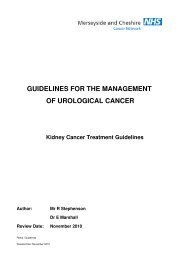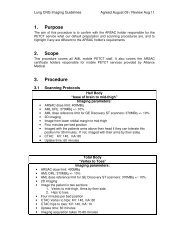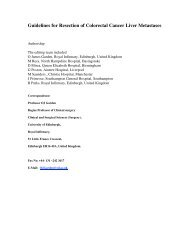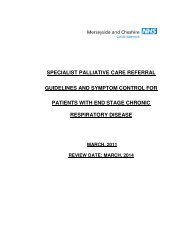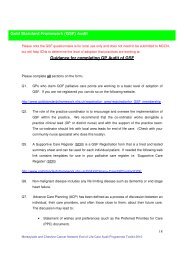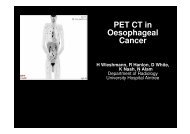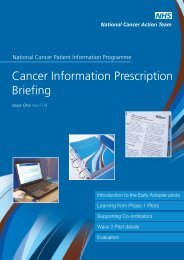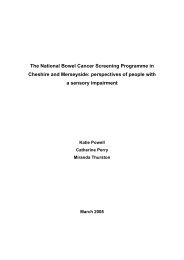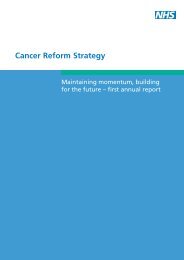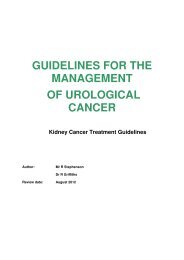Cancer Reform Strategy - NHS Cancer Screening Programmes
Cancer Reform Strategy - NHS Cancer Screening Programmes
Cancer Reform Strategy - NHS Cancer Screening Programmes
- No tags were found...
You also want an ePaper? Increase the reach of your titles
YUMPU automatically turns print PDFs into web optimized ePapers that Google loves.
CHAPTER 11: BUILDING FOR THE FUTURE 125●●●A much larger number of clinicians dedicatea significant part of their working time tocancer (such as many pathologists,radiologists, allied health professionals,general and community nurses, surgeons,physicians, haematologists andanaesthetists);Dealing with cancer patients represents onlya relatively small part of the workload ofGPs. However, they spend much of their timecaring for patients who have symptoms thatmight possibly be due to cancer; andOutside the <strong>NHS</strong> many staff, such as socialworkers or carers, play an important role insupporting cancer patients.11.4 As set out in chapter 1, the number ofspecialists working in cancer related specialtieshas increased markedly over the past decadeand is set to increase further over the next fiveyears. This has been supplemented by significantchanges in the roles undertaken by nonmedicallyqualified staff. Indeed, without thesechanges many of the improvements in serviceswould not have been possible:Workforce development11.5 A key function for each Strategic HealthAuthority (SHA) is organisational and workforcedevelopment, including the development ofstrategic regional workforce plans, based onsupply forecasts and local delivery plans.However the <strong>Cancer</strong> Policy Team and the <strong>Cancer</strong>Action Team should continue to assist the SHAsin this function, ensuring consistency across thecancer workforce. Developments in newtreatments and care settings will requirechanges to the workforce and the cancer teamsare best placed to advise SHAs on the impactthese may have and provide further detailedinformation on cancer workforce profiles.Recent examples of this support include:●●Working with Skills for Health to developskills competences for professionals alignedto patient pathways to inform localised skillmix and training needs assessments;Identifying competence frameworks for thedevelopment of new and extended roleswithin cancer services, for example ClinicalNurse Specialists and the Integrated <strong>Cancer</strong>Care Pathway Care Tracker role; and●●●The introduction of the four tier model fordiagnostic radiographers has beenintroduced with great success in some areas,for example enabling the breast screeningprogramme to be successfully extended towomen up to the age of 70 years;The 4 tier model has also been introduced insome radiotherapy departments, thoughthere is potential for wider uptake of thisapproach; andNurses have been trained to undertakeendoscopy (gastroscopy, flexiblesigmoidoscopy and colonoscopy). This hashelped to reduce waiting times for endoscopyservices and facilitated the roll out of the <strong>NHS</strong>Bowel <strong>Cancer</strong> <strong>Screening</strong> Programme.●Supporting and developing multidisciplinaryteams (MDTs) by identifying and sharing thekey factors for the successful working ofMDTs.11.6 SHAs will also want to consider how bestto make links with those responsible forworkforce development outside the <strong>NHS</strong> such asSkills for Care, which is responsible fordeveloping the skills and qualifications of theadult social care sector.Training11.7 In general, workforce developmentand the commissioning of trainingprogrammes is the responsibility of SHAsand PCTs and should take account of localneeds and circumstances. However, where itmakes sense to identify and commissiontraining pilots at a national level, the<strong>Cancer</strong> Policy Team and <strong>Cancer</strong> Action Teamwill continue to do so. This work will beundertaken in partnership with SHAs.




